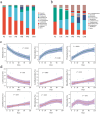Dynamics in gut microbiota diversity, composition, and assembly reveal the adaptability of invasive snail Pomacea canaliculata during hibernation in rice fields
- PMID: 40740324
- PMCID: PMC12307439
- DOI: 10.3389/fmicb.2025.1616681
Dynamics in gut microbiota diversity, composition, and assembly reveal the adaptability of invasive snail Pomacea canaliculata during hibernation in rice fields
Abstract
The gut microbiota plays a crucial role in host immunity and metabolism and may facilitate the adaptation of invasive species to new environments. During hibernation, gut microbial communities undergo compositional shifts to help hosts cope with low temperatures and food scarcity. However, the dynamics of gut microbiota during hibernation in invasive animals remain poorly understood. Here, we conducted an in situ hibernation experiment on the invasive freshwater snail Pomacea canaliculata to investigate changes in its gut microbiota over the course of hibernation. Gut samples were collected at pre-hibernation (day 0) and on the 15th, 30th, 60th, 90th, and 120th days of hibernation, followed by 16S rRNA gene sequencing. Results showed that the survival rate of snails reached 85.7% after 120 days. The Shannon diversity index of gut microbiota increased with the duration of hibernation. Although species richness remained relatively stable, increased evenness led to higher alpha diversity. After 60 days of hibernation, the structure of gut microbial community changed. The dominant phylum shifted from Firmicutes to Bacteroidota (formerly Bacteroidetes) as hibernation progressed. Short chain fatty acids (SCFAs) producing genera such as Acetobacteroides, Bacteroides, Macellibacteroides, and Cetobacterium increased in abundance during hibernation, likely providing an energy source for both the gut and host. Gut microbiota changes appeared to be driven largely by stochastic assembly processes. Additionally, anaerobic bacteria and potential pathogens increased in abundance during hibernation. These adaptive shifts in gut microbiota may help maintain host metabolic and immune functions during hibernation and potentially contribute to the invasiveness of P. canaliculata.
Keywords: Pomacea canaliculata; community assembly; gut microbiota; hibernation; invasive alien species.
Copyright © 2025 Yao, Li, Chen, Zhang, Shi and Qin.
Conflict of interest statement
The authors declare that the research was conducted in the absence of any commercial or financial relationships that could be construed as a potential conflict of interest.
Figures








Similar articles
-
Dynamic response of gut microbiota mediates the adaptation of Cipangopaludina chinensis to Pomacea canaliculata invasion.Microbiome. 2025 Jul 24;13(1):171. doi: 10.1186/s40168-025-02160-4. Microbiome. 2025. PMID: 40708023 Free PMC article.
-
Pomacea canaliculata alters the composition, diversity, function, and assembly of bacterial community in freshwater plastisphere, shifting it closer to gut microbiota.J Hazard Mater. 2025 Jul 10;496:139211. doi: 10.1016/j.jhazmat.2025.139211. Online ahead of print. J Hazard Mater. 2025. PMID: 40714594
-
Variation and assembly mechanisms of Rhinolophus ferrumequinum skin and cave environmental fungal communities during hibernation periods.Microbiol Spectr. 2025 Mar 4;13(3):e0223324. doi: 10.1128/spectrum.02233-24. Epub 2025 Jan 23. Microbiol Spectr. 2025. PMID: 39846756 Free PMC article.
-
The mode of delivery affects the diversity and colonization pattern of the gut microbiota during the first year of infants' life: a systematic review.BMC Gastroenterol. 2016 Jul 30;16(1):86. doi: 10.1186/s12876-016-0498-0. BMC Gastroenterol. 2016. PMID: 27475754 Free PMC article.
-
Gut microbiome-based interventions for the management of obesity in children and adolescents aged up to 19 years.Cochrane Database Syst Rev. 2025 Jul 10;7(7):CD015875. doi: 10.1002/14651858.CD015875. Cochrane Database Syst Rev. 2025. PMID: 40637175 Review.
References
LinkOut - more resources
Full Text Sources
Research Materials

